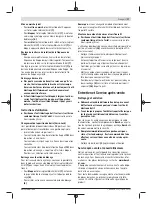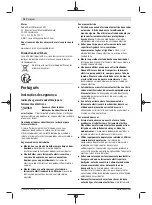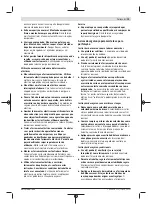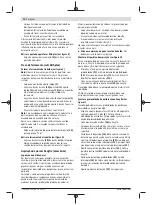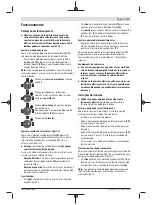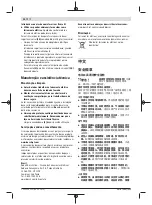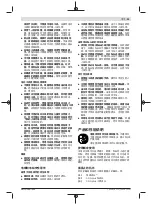
10
| English
The dust extractor must be suitable for the material being
worked.
When extracting dust that is dry, especially detrimental to
health or carcinogenic, use a special dust extractor.
Setting the drilling depth on the dust extraction
attachment (see figure I)
You can also set the required drilling depth
X
when the dust
extraction attachment is fitted.
– Push the SDS-plus application tool into the SDS-plus tool
holder
(3)
as far as it will go. Otherwise, the movability of
the SDS-plus drilling tool can lead to incorrect adjustment
of the drilling depth.
– Loosen the wing bolt
(24)
on the dust extraction attach-
ment.
– Without switching it on, press the power tool firmly
against the surface you wish to drill. The SDS-plus applic-
ation tool must be touching the surface.
– Position the guide tube
(25)
of the dust extraction attach-
ment in its holder such that the head of the dust extrac-
tion attachment rests on the surface to be drilled. Do not
slide the guide tube
(25)
further than necessary over the
telescopic tube
(23)
, so that as much as possible of the
scale remains visible on the telescopic tube
(23)
.
– Retighten the wing bolt
(24)
. Loosen the clamping screw
(21)
on the depth stop of the dust extraction attachment.
– Slide the depth stop
(22)
onto the telescopic tube
(23)
so that the distance
X
shown in the illustration matches
your required drilling depth.
– Tighten the clamping screw
(21)
in this position.
Operation
u
Products that are only sold in AUS and NZ:
Use a resid-
ual current device (RCD) with a nominal residual current
of 30 mA or less.
Start-up
u
Pay attention to the mains voltage. The voltage of the
power source must match the voltage specified on the
rating plate of the power tool. Power tools marked
with 230 V can also be operated with 220 V.
Setting the Operating Mode
The operating mode of the power tool is selected using the
impact/mode selector switch
(10)
.
– To change the operating mode, press the release
button
(9)
and turn the impact/mode selector
switch
(10)
until it clicks into the required position.
Note:
Only change the operating mode when the power tool
is switched off. Otherwise, the power tool may become dam-
aged.
Position for
hammer drilling
into concrete
or stone
Position for
drilling
without impact in wood,
metal, ceramic and plastic and for
screw-
driving
Vario-Lock
position for adjusting the chisel
position
The impact/mode selector switch
(10)
will
not engage in this position.
Position for
chiselling
Setting the Rotational Direction (see figure J)
The rotational direction switch
(8)
is used to change the ro-
tational direction of the power tool. However, this is not pos-
sible while the on/off switch
(7)
is being pressed.
u
Only operate the rotational direction switch
(8)
when
the power tool is not in use.
Always set the rotational direction to clockwise rotation for
hammer drilling, drilling and chiselling.
–
Clockwise:
To drill and to drive in screws, press the rota-
tional direction switch
(8)
all the way to the left.
–
Anticlockwise:
To loosen and unscrew screws and nuts,
press the rotational direction switch
(8)
all the way to the
right.
Switching On/Off
– To
switch on
the power tool, press the on/off switch
(7)
.
– To
lock
the on/off switch
(7)
, press and hold it while also
pushing the lock-on button
(6)
.
– To
switch off
the power tool, release the on/off switch
(7)
. If the on/off switch
(7)
is locked, press the switch
first and then release it.
Adjusting the Speed/Impact Rate
– Adjust the speed/impact rate of the power tool when it is
on by pressing in the on/off switch
(7)
to varying extents.
Applying light pressure to the on/off switch
(7)
results in a
low rotational speed/impact rate. Applying increasing pres-
sure to the switch increases the speed/impact rate.
Overload clutch
u
If the application tool jams or snags, the power trans-
mission to the drill spindle will be interrupted. Always
hold the power tool firmly with both hands to with-
stand the forces this may create and adopt a position
with stable footing.
u
Switch the power tool off immediately and remove the
application tool if the power tool becomes blocked.
Switching on when the drilling tool is blocked may
cause high torque reactions.
Practical Advice
u
Only apply the power tool to the screw/nut when the
tool is switched off.
Rotating tool inserts can slip off.
1 609 92A 5PE | (28.10.2020)
Bosch Power Tools

















